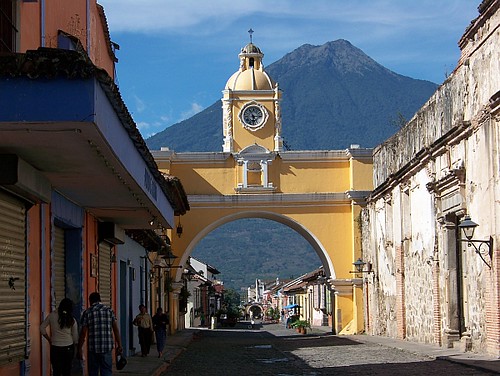- Reasons to work
- For the money
- To be challenged
- For the pleasure/calling of doing the work
- For the impact it makes on the world
- For the reputation you build in the community
- To solve interesting problems
- To be part of a group and to experience the mission
- To be appreciated
Why do we always focus on the first? Why do we advertise jobs or promotions as being generic on items 2 through 8 and differentiated only by #1?
In fact, unless you’re a drug kingpin or a Wall Street trader, my guess is that the other factors are at work every time you think about your work. (PS Happy Birthday Corey.)
Reblogs for 20101121
- WordPress Wins CMS Award
I was just informed that WordPress, in head-to-head voting against Joomla and Drupal, has won this year’s Open Source CMS Hall of Fame award.
We have to be careful because if this trend continues people might think WordPress is a real CMS, useful for more than just a blog. This would ruin our stealth campaign and might bring dozens of new users to the WordPress community. If you could keep this on the DL we’d appreciate it.
We don’t want WordPress to develop a reputation.
Reblogs for 20101116
- TSA Success Story
By now, if you haven’t heard the outrage at the TSA’s “enhanced” pat-down procedures, then you don’t use the internet, and you’re not reading this blog.
They grope children. They touch your junk. The procedures are ludicrously ineffective and harmful from a security point of view. And the naked-picture xray machines are most likely unsafe.
Things like this get me feeling all rebellious and Jeffersonian. So, since I’m flying up to Joyent’s Vancouver offices today, I decided to do a little prep work.
First, I took the UCSF letter, added a bit of highlighting and annotation to make it a bit easier to scan, and printed it out. You can get a copy from http://j.mp/cancer-ray.
I was worried that I’d chicken out. No, not “worried”. I was sure I’d chicken out. Of course I would. I talk a good game about incendiary politics and unconventional ideals, but when the chips are down, I generally do the expedient thing like a nice polite citizen. I’m not one of these “talk down the authorities” types, even though I wish I was.
But then my flight was cancelled, and I learned that I’d have to be in the airport until 12 to catch the next one. The extra time to kill strengthened my resolve. “So what if I’m detained?,” I thought. “I don’t have to be anywhere for 5 more hours.” Plus I was alone, so there wasn’t anyone else’s embarrassment to worry about. I repeated the confidence mantras in my head. They’re expendable workers. I own this place. I’m the boss. They work for me. The only reason I don’t fire them is that they’re cheaper than robots. Etc.
I started talking to the family behind me as soon as I got into the security line, a middle-aged couple with 2 adolescent boys and a girl about 4 or 5. They were amused by my shoes, so it wasn’t too hard to strike up a conversation.
I asked where they were from. Santa Clara. Heading to Toronto for some family thing. I asked if they’d heard about the new X-Ray machines. The dad was tired and apathetic. She said, “Oh, yeah, I heard about those on the news, that if you don’t go through, they grope you or something, and if you do, they take a naked picture of you.”
“Yeah, it’s messed up. Did you know that the UCSF oncology department thinks they pose a serious health risk, especially to children or anyone at risk for breast cancer?”
“Whoa, no, I didn’t know that!”
I handed the paper to the mom. Bam.
“Oh, honey, you should read this!! … Oh my god…”
Turns out she’s a breast cancer survivor. And her doctor has told her to avoid x-rays, even at the dentist, unless absolutely medically necessary. And she didn’t realize that “millimeter wave digital backscatter detection” used x-rays, because the TSA doesn’t actually put that on the sign.
She did the rest.
When we got to the scanner, I opted out. Then they opted out. She’d already convinced the family behind them to do the same. Her response to the TSA agent was awesome, I wish I’d thought of it:
“Ma’am, please step over here.”
“No thanks, I’ve already had cancer, just feel me up or whatever.”
After the first 4 “OPT-OUT” calls, they just passed us all through the regular metal detector. No one got groped.
Information, properly delivered, is power.
Addendum The revolt was emotionally satisfying, and I totally recommend doing it, but ultimately it’s only a drop in the ocean. From where I’m sitting, I can see the security line, people holding their hands up in the little booth.
So, do make trouble. On-the-ground rebellion is important. But also tell your legislator. There’s a senate oversight meeting tomorrow, so please call these people and tell them how you feel.
You’ll leave a voicemail. It’s easy and takes 2 seconds. Just call up and say “I think that the TSA has gone too far. Body scanning and inappropriate groping are unconstitutional and wrong. If you want my vote, change the policy.”
Reblogs for 20101116
- This Posters shows, how many floppies are…

This Posters shows, how many floppies are enough for current softwares. Result (Approximate) 46 disk for iTunes 8.02, 358 disk for Adobe Photoshop CS4, 1760 disk for the Sims 3, 12 disk for Firefox 3
(Want more? See NOTCOT.org and NOTCOT.com)
- Wild thing
“Once a little boy sent me a charming card with a little drawing on it. I loved it. I answer all my children’s letters — sometimes very hastily — but this one I lingered over. I sent him a card and I drew a picture of a Wild Thing on it. I wrote, “Dear Jim: I loved your card.” Then I got a letter back from his mother and she said, “Jim loved your card so much he ate it.” That to me was one of the highest compliments I’ve ever received. He didn’t care that it was an original Maurice Sendak drawing or anything. He saw it, he loved it, he ate it.”
– Maurice Sendak
[via Catherine Campbell]
Reblogs for 20101106
- 8 Exotic Destinations You Can Afford
Shared by Felix
This list is really not helping my travel addiction go away… but I’m glad it’s here anyway. Cheap countries FTW!
(Photo: Stuck in Customs)This is a guest post by Tim Leffel, a travel destinations expert who has dispatched articles from five continents over a period close to two decades.
Think world travel needs to be expensive? Think again…
Enter Tim Leffel
Like an annoying house guest who keeps packing but doesn’t leave, this recession keeps dragging on. That downsized international vacation can still be exotic though—if you pick the right destination. Or if you really want to alter your finances for the better, move to one of these places as an expat.
The dollar is in healthier shape than it has been many times in the past in relation to the euro and pound sterling, but a trip to one of Western Europe’s capitals still feels like a shopping trip to Tiffany’s. Australia is not much better, and a trip to Japan could drain your whole life savings in a week.
Here’s a better idea: go someplace where your travel dollars are still worth a bundle.
Below are some of the best deals on the planet right now, destinations that are relatively easy for travelers and also easy on the wallet.
1. Egypt

Photo: Jungle_BoyDespite having some of the world’s best-known monuments, Egypt struggles to fill its abundant hotels. With less-than-wealthy locals far outnumbering the tourists, it’s easy to find a bargain meal or a guide or taxi driver. (They’ll find you whether you need them or not.) Admission prices for the ancient pyramids and temples are reasonable, generally ranging from $3 to $14.
Sample deals: a first-class train ticket from Cairo to Luxor for $17; a Nile-view deluxe double room in Luxor for $60 with breakfast; a private room by the sea in Dahab for under $20; entrance to the Nubia Museum in Aswan for $4; a falafel sandwich at a Cairo street stall for 40 cents. There’s no great independent travel site for the whole country but Egypt’s official tourism site is better than most.
2. Indonesia

Photo: Erik K VelandThis Southeast Asian nation is one of the most diverse and attractive destinations in the world, with a long string of volcanic islands and a range of topography and culture. It could also be the best value on the planet, with cheap hotels going for $5 a night, often right beside great snorkeling spots. Bali is the most developed island, but even there you can find plenty of deals. On Java, Sumatra, and Sulawesi, however, it’s easy to branch out like an intrepid explorer or get pampered on the cheap in the most popular spots.
Sample deals: a double room with pool and breakfast in Yogyakarta, Java for under $20; a five-day small ship cruise between Lombok and Flores islands via Komodo for $200 per person including meals; a first-class train seat from Jakarta to Yogyakarta for $25; an hour-long massage for $8-$15; a day’s motorbike rental on Bali for $10. Indo.com has a good listing of mid-range hotels in Bali and some other areas while the official Indonesia tourism site has travel info and enticing photos of the diverse islands.
3. Mexico

Photo: Tim LeffelIn mid-2008, the peso was at 10 to the dollar. Now it’s close to 13. That’s a discount of more than 25 percent in a country that was already a deal. Plus Swine Flu followed by drug gang violence on the U.S. border has meant that travelers have tremendous bargaining power on hotels and tours. To find the best values, visit the historic colonial cities or beach areas where Americans don’t outnumber the locals. (As in places where there’s no Señor Frog’s in sight.)
Sample deals: a three-course lunch at a market stand for $4; nice hotels in centuries-old colonial buildings for under $75 double with breakfast and Wi-Fi; a round of Negra Modelos for five at nearly any bar, including gratis snacks, for $10; and some of the nicest deluxe buses in the hemisphere for $6 to $8 per hour of travel. It’s a big, diverse country, but here’s an extensive set of links and the best books on one page: Mexico travel resources from Travelers-tool-kit.com.
4. Honduras

Photo: Tim LeffelFew people knew anything about this country until it was all over the news last year when the president got forced out of office. You can find fabulous deals on scuba diving packages on Roatan Island. This Caribbean island sits next to the second-longest coral reef in the world, and every hotel seems to offer attractive package plans no matter the season. On the mainland you’ve got tropical national parks, the rugged Moskito Coast, and Copán, one of the key Mayan sites in the Americas and a great little colonial town.
Sample deals: $35 white-water rafting trips; weeklong learn-to-dive packages with room, breakfast, and transfers for under $600; a cold coconut with a straw for 40 cents; and admission to the Copán archeological park for $10. For more info, see the Honduras Tips site or Roatan Online, or see more travel prices in Honduras here.
5. Guatemala

Photo: Tim LeffelThis is only a shade farther to fly than Mexico, but it is a truly exotic destination. The descendants of the Mayans still dress in traditional clothing in the villages surrounding stunning Lake Atitlán. The Spanish colonial buildings in the city of Antigua are older than anything left standing in our historic city districts. The sprawling archeological park of Tikal is the granddaddy of Mayan ruins, and still surrounded by jungle.
Sample deals: taxis in Antigua for $4; great hotels with a view on Lake Atitlán for $60 a night; a week of private Spanish lessons including homestay starting at $180; a zipline canopy tour near Tikal for $30; three pounds of bananas or avocados for a dollar. La Ruta Maya Online is the best resource for hotels, tours, and Spanish language schools.
6. Peru

Photo: Tim LeffelMachu Picchu alone is worth the journey, but it’s just the start in this value-packed country. Inca ruins are scattered all around the Sacred Valley, and Cuzco is one of the most attractive cities in South America. There is also hiking in the Andes, admiring colonial architecture on the streets of Arequipa, trips through the Amazon, boating across the highest lake in the world, and flying over the strange Nazca lines.
Sample deals: Bus from Arequipa to Colca Canyon – $6; a big traditional lunch and a beer for $7; simple restaurant meal in the countryside $6 for two; entrance to the Inca Museum in Cuzco for $1.50; cheap single room or hostel bed $4-$10; airport taxi in Cusco $4. Andean Travel Web is an exhaustive resource site for trekking info, hotels that are a good value, and general travel info.
7. Thailand

Photo: ccdoh1As with Honduras and Mexico, visitor numbers plunged when Bangkok was all over the news recently, so there are plenty of deals on airfare, tours, and hotels. This is a popular destination for travelers of all budget levels. Thailand continues to be one of the best bargains in the world in terms of hotel prices, and with a well-developed infrastructure, it’s easy to get around and see what you want to see, be it historic ruins, Buddhist temples, or tropical beaches.
Sample deals: a standard double at a true 5-star hotel in Bangkok for $250 or less per night—or a cheap place to flop down and sleep for 1/20th of that price; admission to the main ruins in Sukothai for under $2; a first-class round-trip sleeper train from Bangkok to Chiang Mai for about $40; a Skytrain ticket across Bangkok for about $1.30. The hands-down best travel resource for Thailand is Travelfish.org. They also put out some great iPhone/iPad apps on specific regions and islands.
8. Czech Republic

Photo: Tim LeffelIn much of Europe, prices in the big cities are often double what you find in the countryside. This is especially true in Eastern European countries like the Czech Republic, where vacationers on quick weekend breaks have driven up hotel and restaurant prices in Prague. In the smaller towns and cities, however, the country is one of Europe’s remaining great values. Castles on hill crests, some of the world’s best beer for a dollar or so in a pub, and winding cobblestone streets without crowds—Ye Olde Europe without the new Europe prices.
Sample deals: a room at the best hotel in town across Moravia for under $100 with breakfast; fully equipped hybrid bike rental for $25 a day; sommelier guided 12-bottle tasting at the Wine Salon of the Czech Republic in Valtice for $19; a train ticket from Prague to anywhere in the country for $12 or less. The official Czech Tourism site is excellent while MyCzechRepublic has good general info on different regions plus a message board. See more Czech prices outside Prague here.
To dive in deeper on any of these cheap destinations and see the current situation on the ground, check the message boards at LonelyPlanet.com and BootsnAll.com.
###
Travel writer and website publisher Tim Leffel is author of “The World’s Cheapest Destinations” and runs the Cheapest Destinations blog.
[This post is an updated version of an earlier article that appeared in the Boston Globe travel section.]
Reblogs for 20101105
- The Danger of Measuring Emotions
An easy way to identify a future dilemma is to spot two polar, but entirely sensible, reactions to an emerging practice or technology. Which is just what I happened to find when reading through a couple recent articles on new efforts to measure emotions–which, depending on your perspective, will either open up huge opportunities to improve the lives of autistic children, or usher in a massive invasion of personal privacy. Or both.
Let’s start with the less controversial application. As Technology Review reports, a Massachusetts-based startup company called Affectiva has developed a wearable bracelet that can measure “stress and excitement by measuring slight electrical changes in the skin.” In effect, the wearable bracelet can provide continuous, real-time monitoring for changes in emotional states–and offer a tool to help caregivers of autistic children, who frequently struggle to express emotions.
It works like this:
When a person–autistic or not–experiences stress or enters a “flight or fight” mode, moisture collects under the skin (often leading to sweating) as a sympathetic nervous system response….
“When you see this flight-or-fight response, it doesn’t tell you it’s definitely stress, it just tells you something has changed,” says [MIT’s Rosalind] Picard. “Are they excited, hurting, are they stressed by a sound or person in the room? It doesn’t perfectly correspond to stress as it can also go up with anticipation and excitement, but when you see it change, you know something’s going on and you can look for the cause.” She adds that having clues to a person’s stress levels, which might not otherwise be detectable, could give caregivers and researchers more insight–and possibly a way to anticipate–the harmful behaviors of autism, such as head banging. Caregivers can try to identify and block sources of stress and learn what activities restore calm.
With an example like a child banging his head against the wall due to unexpressed emotion, it’s easy to see how caregivers could benefit from a tool like that helps them anticipate emotional distress.
Of course, it’s also to see how just about anyone could benefit from having a better understanding of the emotions of others. I’d love to know, for example, which parts of my research presentations trigger strong biochemical reactions.
And, it turns out, I’m not the only one who would like to have the ability to measure other people’s emotions–and that’s beginning to cause some backlash. As Fast Company reports, the U.K.-based security firm Aralia Systems is developing a security camera that can detect emotional responses–even in the darkness of a movie theater.
The intention is to produce rich data that can measure the details of an individual’s face. Aralia will leverage 3-D face recognition technology that the university is already developing. When you sit in the audience of a theater with their system, you’ll be illuminated with an infra-red beam, and three or more cameras will continually monitor the crowd to create stereoscopic images–just like the 3-D digital cameras that are now launching on the consumer markets.
The system should be able to detect a great deal. It will know the direction your face is pointing in, your expression, whether you’re shocked by something, whether you’re sitting in a family group or on your own, at what point you get bored, and so on. This is invaluable data for marketers, who can gauge how well their ad messages are getting across. Potentially, they could change the ad’s placement in the reel between showings to see if they get a better reaction.
Computer World, in an article titled “Anti-Pirating tool will harvest and market your emotions,” reacted by describing the system as “a massive invasion of privacy.” Which, despite the alarmist language, sounds fairly reasonable. I don’t know many people who want their emotions to be continuously and surreptitiously monitored by random businesses.
And that brings me back to the core dilemma here. In the coming decade, data about our individual bodies–including our subjective states–has enormous potential to improve our lives. We will rely on innovations, like the two I’ve mentioned here, to help us measure those subjective states. And at times, we may benefit, enormously so, from having the ability to share these shifts in emotional states with others.
But our moment-to-moment emotions are incredibly personal. Many of us go to great lengths to keep hidden and have absolutely no interest in having others track, measure and mine those emotions without asking.
Reblogs for 20101103
Reblogs for 20101030
- Paris versus New York
Paris versus New York is a friendly visual match between those two cities, as seen by a Parisian-based-and-lover on New York : details, cliches and contradictions. Absolutely fantastic.
(thank you Jolayne)
Reblogs for 20101030
Reblogs for 20101022
- thedailywhat:
Unusual Jewelry of the Day: “’Til Death Do Us…

Unusual Jewelry of the Day: “’Til Death Do Us Part” engagement ring knuckle duster by Kate Bauman.
4” x 3”. Sterling silver, cubic zirconia. 2006.
[buzzfeed.]
- Photo









